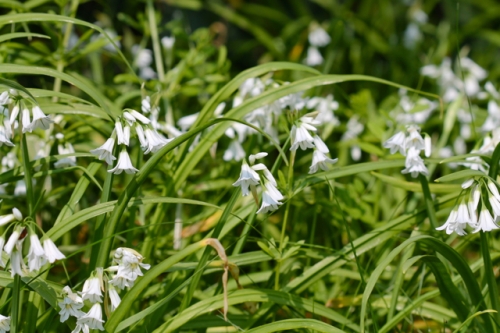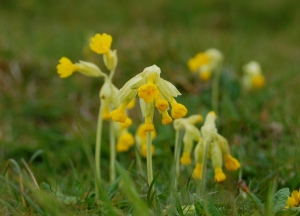
From top left clockwise: Nettle, hawthorn blossom, cleavers, ground elder, ground ivy, garlic mustard/jack by the hedge, dandelion flowers, hawthorn leaves, dandelion leaves.
One of the things I love most about spring is that it is probably the time when picking plentiful quantities of wild food is the easiest, at least in temperate northern zones such as the area in which I live. There are many edible wild spring greens in the hedgerows, woods and waysides and in no time at all you can have an abundant harvest for creating delicious and healthful meals and teas.

A mix of wild and cultivated salad leaves decorated with primrose, three cornered leek and heartsease flowers.
Eating even small quantities of wild foods regularly is one of the best things you can do for your health as they are so nutritionally dense, vibrant, seasonal and fresh. So many of the best wild foods are those we consider weeds, but when we look at the qualities of these plants, how tenacious and insuppressible they are, we can see that their strength and vitality surely makes for a more fortifying meal than those cultivated plants that have been shipped half way round the world and sat on supermarket shelves for days. I think weed is a derogatory term, the four letter word of the plant world, which I will henceforth refer to as w**d. I do however reserve the right to use it, along with other four letter words, in the presence of my arch-nemesis ground elder.
At this time of year we have a lovely mix of mild tasting moistening greens, like the young lime/linden and violet leaves, and more drying or pungent herbs like nettles, young yarrow leaves, jack-by-the hedge and the dead nettles. This makes for a perfect balance of nourishing and toning qualities to help build us up and get us into shape after winter.
The three cornered leek or wild onion is one of the most delicious additions to spring salads, tasting something like a spring onion, and the flowers make beautiful decorative additions to any meal and are also edible. They are more common in the south west than the south east and I don’t find many growing near me but luckily it has spread all over my parent’s garden so I got to pick lots when visiting recently.
From a distance it looks a little like white bluebells or even snowdrops but can be easily differentiated close up by the shape of the flowers and the distinctive triangular stem, hence the common name of three cornered leek. Also the smell of onion is a give away. Do be sure of your identification as both snowdrop and bluebell bulbs are poisonous.
Wavy bittercress is a very common spring salad green which has delicious leaves and flowers and tastes much like normal cress.
Lady’s smock, also known as cuckoo flower, is another edible mustard family plant with deliciously peppery leaves and flowers.
Jack by the hedge or garlic mustard is also in the mustard family or Brassicaceae. This family used to be known as the Cruciferae so if you have an older plant identification book you will find this name instead.
Nettles are found in abundance at this time of year and are a true superfood for the blood. You can read more about them in a previous post here.
Pick cleavers by the handful for use in cold infusions and juices, instructions for which can be found here.
Wild garlic is one of the true delicacies of the season. If, like me, you love the fiery garlic taste then make it into a pesto by itself but if it is a bit too intense for your palette you can tone it down with nettles or shop bought herbs like basil. More about wild garlic can be found here.
Do remember when picking wild greens to be absolutely 100% sure of your identification as some edibles have poisonous lookalikes. Also avoid the sides of paths where dogs are commonly walked and always, always pick with respect to the environment and don’t over harvest. Finally avoid the edges of fields unless you know the land to be organically managed.

At the back; cleavers cold infusion and hawthorn blossom tea. Centre; nettle pesto with jack by the hedge and ground elder. Front; wild green salad of hawthorn leaves, jack by the hedge, dandelion leaves, violet leaves and white dead nettle with nettle pesto and dandelion flowers on toast, nettle and ground elder soup.
Spring greens and flowers also make for wonderful teas.
Ground ivy has a pleasant but musky flavour which is nice in teas when mixed with something lighter like a little mint from the garden. It is great for stuffy sinuses that can go along with spring allergies.
And the most wonderful spring tea of all in my opinion is hawthorn blossom, the very Queen of May herself. Read more about hawthorn blossom here.
I have also written a post on harvesting spring greens in this issue of the Mother magazine.
Wishing you all a joyous Beltane and a marvellous May Day!















